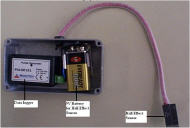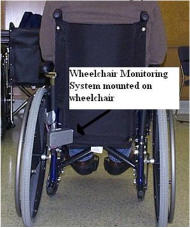Mary C. Reiter, B.S.
ABSTRACT
The objective of this project was to design, fabricate and test a wheelchair monitoring system (WMS) that would provide rehabilitation professionals and consumers with information about the types of activities an individual performs while using their wheelchair. The WMS uses commercially available instrumentation. The WMS is capable of recording the distance traveled over relatively long periods of time (weeks as opposed to hours). Data was collected while an individual without a disability used a manual wheelchair. The individual performed four indoor tasks and traveled throughout the community. The WMS successfully records the time, distance, velocity and frequency of use in the community. The WMS may not be appropriate for comparing wheelchairs during short (less than a minute) intervals.
KEYWORDS: Wheelchair, Data Logger, Rehabilitation Engineering, Community Participation
INTRODUCTION:
The development of a wheelchair monitoring system (WMS) is intended to describe quantitatively how individuals use their wheelchair in their homes and in the community. In combination with other technologies, for example a force/ moment sensing handrim (SMARTWheel) [1], an accelerometer, and/or pressure sensing system mounted on the seat cushion, this information may provide consumers, rehabiltation professionals (Occupational Therapists, Physical Therapists, Rehabilitation Engineers) , wheelchair manufacturers and policy makes with quantitative information not currently available to make well-informed decisions. These decisions could range from selecting the most appropriate wheelchair to defining standards for the length of time of cross-walk lights at traffic intersections, and creating universally accessible environments.
The objective of this project was to design, fabricate and test a WMS that would provide rehabilitation professionals and consumers with information about the types of activities an individual performs while using his/her wheelchair. The WMS will be able to record information in the individual’s home and community environment, and for relatively long periods of time (i.e. on the order of weeks, as opposed to hours). This information will aid in the selection of the most appropriate wheelchair, by providing quantitative measures with which to compare wheelchairs. The development of this system will be applicable to both individuals who use a manual wheelchair or a power wheelchair.
 |
The design criterion for this system were for it to be capable of recording the distance traveled while propelling the wheelchair (manual and power wheelchairs) and small in size and lightweight so as to not interfere with the propulsion of the wheelchair. Additionally, the system had to have potential for long-term data collection (greater than one week) and robust in order to survive a potentially harsh environment (rain, snow, salt, etc.). The system had to be non-obvious to both the individual using the wheelchair and the individuals in her/his environment. Numerous options were thoroughly investigated, ranging from a custom designed system [2, 3] to commercially available systems. Based on the design criteria listed above and the technical requirements (sampling rate, battery life, memory, programmability), the following commercially available system components were chosen. The system design was composed of a data logger, sensor, power supply, and magnet. The key component in this study is a commercially available data logger, the Pulse 110 Voltage Recorder, from MadgeTech, Inc. (Warner, NH). These systems are typically employed in the transportation industry to record events that occur as shipments are transported globally. The data logger records the number of pulses per time interval (as selected by the investigator) transmitted by a sensor. The data logger has an internal 3.6V Lithium battery that has a typical battery life of 2 years. The sensor investigated for use in this study was a Hall Effect sensor switch. The sensor sends a voltage to the data logger when it senses a magnet mounted on the wheelchair wheel. The Hall Effect sensor requires a power supply between 3.8 to 24V, and in this project a lithium 9V battery was used . The data collected will be the number of revolutions of the wheel per time interval for each trial. The recorded data on the data logger can be downloaded on to a PC for data analysis using MATLAB. Time, displacement, velocity, acceleration, and deceleration values will be quantified and statistically analyzed.
. It is expected that the WMS can successfully detect and record the distance traveled, the velocity, and the incidence of use of an individual using a manual wheelchair over relatively long periods of time.
METHODOLOGY:
 |
The system components were obtained, fabricated, and tested. One individual participated in the pilot study. Informed written consent was obtained prior to any data collection. The participant performed a set of five skills while using a Quickie LXI manual wheelchair (axle in most rearward position) with a Stimulite SlimLine seat cushion and a sling back support.
The wheelchair was adjusted to match the anatomical features of the individual. The skills have been used in previous wheelchair studies [4, 5] and are some of the primary skills that individuals perform when using a manual wheelchair. The five skills are as follows: 1) Traveling up a ramp compliant with the Americans with Disabilities Act Accessibility Guidelines (ADAAG) [6]; 2) Traveling down a ramp compliant with the ADAAG; 3) Traveling across tile for 10m; 4) Traveling across carpet for 10m; 5) Community protocol. The subject performed the first four skills three times each. At the end of skills 3 and 4 (tile and carpet) the individual gave the wheelchair one final push (one final stroke) and let the wheelchair coast to a stop. Skill 5, the community protocol, involved the subject traveling around a city block on a sidewalk and crossing a city street with a stoplight. Skill 5 was only performed once. All adjustments were made to the wheelchair to match the anatomical dimensions of the individual.
Data from the skill testing was downloaded from the data logger onto a PC and analyzed with MATLAB. With the circumference of the wheel and number of pulses recorded from the data logger, the distance traveled was calculated. Additionally, the velocity and acceleration were calculated. Statistical analyses were performed where appropriate.
RESULTS:
 |
The wheelchair monitoring system successfully recorded the number of revolutions of the wheel in each trial. The velocity and acceleration were calculated using a finite difference equation. Data analysis showed that for skills (1) Traveling up a ramp, (2) Traveling down a ramp, and (3) Traveling across tile the results were identical. Total distance traveled was 37.69 ft, and the average velocity was 3.42 ft/s. For skill (4) traveling across carpet the distance traveled was 31.42 ft, and the average velocity 2.62 ft/s. Skill (5) community protocol resulted in a total distance traveled of 1,608.50 ft, and an average velocity of 2.81 ft/s. The acceleration data are not reported due to the low resolution of the data logger as will be discussed below.
DISCUSSION:
The WMS successfully recorded the number of revolutions of the wheel during all of the skill testing. The distance traveled calculated from the data corresponded to the actual distance traveled. However, the velocity and acceleration calculated from the data did not correspond to the actual values in the first four skills (Traveling up and down a ramp, Traveling across tile and carpet). This was probably due to the fact that only one magnet was used. The resolution of the wheelchair monitoring system can be improved with additional sensors and magnets, and accurate velocity and acceleration values can be obtained. Also, with three hall effect sensors it is possible to determine direction of travel from the data. In the community protocol, the subject traveled on a city sidewalk and crossed two streets. The wheelchair monitoring system successfully recorded the appropriate distance traveled, the instances when the subject was not moving (e.g. waiting at a stoplight) and when he increased his speed (e.g. to avoid traffic due to the short walk signal).
FUTURE WORK
Along with increasing the resolution of the WMS with additional magnets and determining the direction of travel by adding with additional sensors, other improvements can be made. The QuadVolt 4 Channel Low Level Voltage Recorder from MadgeTech, Inc can record data from up to four sensors and for a much longer period of time. For example, the increased number of channels allows determining the direction of travel and could include a pressure sensor or an accelerometer. The system can then simultaneously record when a person is in their chair (pressure sensor), the distance traveled (hall effect sensor), and/or vibrations and shocks (accelerometer). The testing of more wheelchairs with multiple users will allow comparisons to be made between different wheelchairs and wheelchair configurations.
REFERENCES:
- Asato KT, Cooper RA, Robertson RN, Ster JF "Smartwheels: Development and Testing of a System for Measuring Manual Wheelchair Propulsion Dynamics" IEEE Transactions on Biomedical Engineering, Vol 40, No. 12, December 1993.
- Cooper RA, Thorman T, Cooper R, Dvorznak MJ, Fitzgerald SG, Ammer W, Song-Feng, Boninger M, "Driving Characteristics of Electric-Powered Wheelchair Users: How Far, Fast, and Often Do People Drive?" Arch Phys Med Rehabil, Vol 83, February 2002.
- Spaeth DM, Arva J, Cooper RA, "Application of a Commerical Data Logger for Rehabilitation Research". Proceedings of the 23 rd Annual RESNA Conference Technology for the New Millennium. Orlando (FL); 2000 June 28-July 2. p. 313-5.
- Kirby RL, "Wheelchair Skills Program (WSP_: Version 3.0," Dalhousie University, Halifax, Nova Scotia, Manual November 24, 2004.
- Kilkens OJ, et. al "The Wheelchair Circuit: Construct validity and responsiveness of a test to assess manual wheelchair mobility in persons with spinal cord injury," Arch Phys Med Rehabil, Vol 85, pp.424-31, 2004.
- Department of Justice “Nondiscrimination on the Basis of Disability by Public Accommodations and in Commercial facilities”, 28 CFR Part 36, ADA Standards on Accessible Design, 1 July 1994.
Mary C. Reiter, B.S.
Assistive Technology Unit
University of Illinois-Chicago
1640 W. Roosevelt Rd., Rm 408
Chicago, IL 60608
mreite2@uic.edu
Ph. 312-413-3603